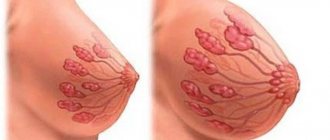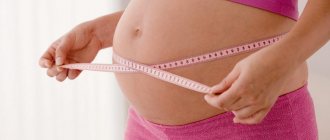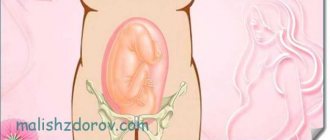A mother's main job begins with the birth of her baby. It is especially important to prepare for feeding. With the right attitude, the baby will be full, which means the mother will be happy and calm.
During pregnancy, the body actively prepares for lactation. Frequent advice - to avoid stress in every possible way - is also relevant for lactation. Stress is not only various worries, unfavorable events at work and in personal life, but also overwork. Stressful conditions affect hormonal levels, which can lead to problems with milk supply.
A pregnant woman needs to concentrate on the positive aspects, creating favorable circumstances for bearing a child.
Preparing for feeding - breast massage
In children's clinics there are still posters on breastfeeding with advice to rub your breasts with a rough washcloth and put hard rags in your bra. Now these methods are no longer relevant, moreover, they are not recommended by mammologists. Irritating actions increase the risk of cracked nipples during feeding.
To maintain the shape of the bust and prevent lactostasis, mammologists advise performing a small massage. The mammary glands are kneaded with gentle movements in a circle. It is also recommended to do a relaxing massage in the shower with streams of water from a watering can or using a soft washcloth.
During pregnancy, a woman should pay attention to the shape of the nipple. If the shape of the nipple is retracted (when it is in the dimple) or flat (when the nipple does not protrude above the areola), then you need to regularly massage them with pulling movements of your fingers using baby cream.
Proper latching of the baby to the breast allows you to avoid microtraumas, and the baby receives milk and does not remain hungry. Therefore, it would be a good idea to study information on methods of breastfeeding and what proper nipple latching looks like. A lactation specialist can also provide assistance with breastfeeding.
How to restore breasts after feeding
The right diet
For more productive restoration of the mammary glands after lactation, the following products will help to enrich your diet:
- any lean meat;
- milk, at least two glasses a day;
- fish fat.
Physical exercise
Exercises to restore breast elasticity and height are as follows:
- Push-ups with arms wide apart - 10 times, 3-4 sets.
- The starting position is lying on your back with your knees bent. Hands with dumbbells are spread to the sides and lowered to the body. The exercises are repeated alternately 10-15 times.
People's advice - black tea . Place napkins soaked in tea leaves on your nipples several times a day. It's even better if you have oak bark. Brew it as directed on the package, let it cool, and bathe your papillae or make compresses in the same way as tea compresses.
Massage
Massage helps restore skin tone and elasticity. The technique consists of the following manipulations:
- stroking circular movements on the mammary glands;
- intense chest kneading;
- massage with fingertips;
- patting the chest with the ribs of the palms.
We have a detailed list of products for a nursing mother in our article. What is possible and what is not!?
Find out what sedatives you can use when breastfeeding here. Soothing teas are the best remedy!
Cold and hot shower
Procedures with alternating hot and cold effects strengthen the walls of blood vessels, increase tissue elasticity, and improve blood circulation. It is enough to apply a shower jet to your chest alternately with hot and cold water for 10 seconds.
The success of lactation largely depends on how well a woman prepares her mammary glands for future feeding. We should not treat this issue with disdain, despite the fact that nature has thought through a lot for us. Simple manipulations will help maintain not only the health, but also the beauty of your breasts.
What you need to prepare in case of force majeure
After the baby is born, he is brought to the breast, and the baby receives his first food - drops of colostrum, and also gets acquainted with the mother's immunity. At the same time, no one is immune from the occurrence of moments that prevent the baby from feeding from the first hours of life.
Surgeries during childbirth, including caesarean section, can delay the flow of milk, and situations may also arise when the baby is separated from the mother in the hospital. Therefore, you can choose and buy a breast pump in advance.
Constant pumping before each feeding stimulates the production of prolactin, a special hormone that is responsible for lactation. Gradually, the amount of milk with regular use of the breast pump will increase, and the baby will not remain hungry.
What is your nipple shape?
Some mothers who have flat nipples or inverted nipples begin to panic that this will somehow interfere with feeding and that the baby will be uncomfortable. In fact, it won't hurt at all. You just need to prepare your nipples in advance.
The first thing to do is check the form. Perhaps your suspicions are unfounded and there is nothing wrong with the form. Take the nipple halo with two fingers (index and thumb) and press lightly - if the nipple is pulled inward, then the shape is not entirely correct; if the nipple sticks out forward, it is convenient for feeding the baby. Also, a normal nipple, when exposed to cold, is pulled forward and takes on a convex shape, a retracted nipple is pulled into the areola, a flat nipple does not change shape at all.
Flat or inverted nipples
- Massage. But you can change it slightly to make it more convenient to feed your baby. A fairly effective method is massage. The first and simplest is pulling and twisting the nipples. Using two fingers, gently pull out the nipple, twisting it slightly. There is probably no need to remind you that your hands should be washed clean, and your nails should be trimmed and filed? But don’t overdo it - the skin on them is very delicate, you can damage it. Also, too much nipple twisting can cause increased uterine tone.
There is also a Hoffman maneuver that can be used to pull out the nipple. Place two thumbs at the base of the nipple and begin gentle rubbing movements with one finger up, the other down, then to the sides. Thus, the adhesions at the base of the flat (or inverted) nipple are weakened, and it is brought out. It is recommended to do this exercise for a few minutes 2-5 times a day. This method is a little controversial, some experts consider it effective, others are extremely against it.
- Special bra with special inserts and nipple correctors. The bra gradually changes the shape of the nipples, making them more convex. You can also find special correctors in the pharmacy that operate on the principle of a pump. But you can’t wear them often - start putting on correctors a month before the baby is born for about 5 minutes a day, gradually increasing the time to 30 minutes, and before engaging in such procedures, consult a specialist. After your baby is born, continue to wear the correctors before feeding for 15 minutes. Correctors and covers apply pressure to the areola area and help the nipple to stretch out.
Avent nipple shape corrector
Medela Nipple Shaping Pad
- The third method is a breast pump. Use it after you start feeding, but check in advance to see if you have any contraindications to pumping. This also helps draw out the nipples.
Under no circumstances should you listen to “advisers” who recommend switching to artificial feeding if your nipples are too flat (do not use a pacifier or a bottle with a pacifier for supplemental feeding. Remember that in the case of inverted nipples, after a bottle with a pacifier, you will definitely struggle with “ nipple confusion” in your baby;). Even if you didn’t have time to prepare your breasts for feeding before the baby was born, don’t worry, the baby will do everything on his own. As he feeds, he will gradually change the shape of his nipples using his lips. In this case, try to use bottles, pacifiers and pacifiers to a minimum.
What to do about nipple sensitivity
Hypersensitive nipples make every feeding torture. You are distracted by unpleasant sensations, and this interferes with comfortable feeding of the baby. Preliminary preparation of the nipples will help get rid of the problem. There are several ways to do this.
- Bra made of rough fabric. The fabric should not be too stiff so as not to injure the skin, but at the same time rough enough to help the halo get rid of excess sensitivity.
- Walk without a bra more often - give your breasts air baths for 10-15 minutes every day (walk bare-chested around the apartment). You can go to the nearest store without a bra - 10-15 minutes is just enough. In warm weather, you can bare your breasts outside in your summer cottage.
- Another way is massage with imitation of feeding a baby. Take the nipple with two fingers, squeeze it lightly and begin to pull. But do not put too much pressure on the mammary glands - the body may think that feeding time has already begun.
- Do not rub your nipples or use lotions containing alcohol! These manipulations violate the protective layer of the areola and injure the nipples.
The baby is born! How to feed?
There are two approaches to feeding - on the clock or on demand. Each of them has its pros and cons. You can study both methods in advance to decide, or you can try them one by one to understand which one is closer to mother and child.
In both cases, there remains the possibility of a lactation crisis, when the amount of milk suddenly decreases, or the baby’s demands increase. Patience and calmness, as well as the advice and assistance of an experienced mammologist, will help in this situation.
Not always and not everyone’s breastfeeding goes smoothly the first time. The main thing is to be patient and believe in yourself.
Pull?
If you see that your baby is having a hard time latching onto your breast, don’t despair. There are several methods for correcting the shape of the nipple. This will require a little extra effort on your part. So, what can you use to “stretch” your nipple?
Nipple formers.
These are small convex cups with one large hole in the center and several small ones on the periphery. Nipple formers are inserted into the bra and positioned around the nipple. Light pressure is created on the connecting muscles of the chest and the nipple is pulled out through the central opening. The remaining holes provide ventilation to the breasts, keeping the nipples dry. It is recommended to use them 20-25 minutes before feeding. These “chest shells” can be worn during the last three months of pregnancy, gradually increasing the wearing time to 8 hours in a row. They are absolutely harmless and completely invisible to others.
Breast pump.
You can resort to its help immediately before feeding. Within 30-60 seconds of pumping, the nipple is stretched, and the baby is already better attached to it, and most importantly, the nipple is properly attached. And the milk pumped out by a breast pump can be collected and used, for example, to create a milk bank.
Hoffman technique
This method removes the base of the nipple and makes the areola softer. To use this technique, place your thumbs on either side of the nipple of the breast you will be feeding. Stretch the breast skin to the sides with your fingers using stroking, slightly pressing movements. Move your thumbs, placing them both above and below the nipple. Use this method a few minutes before you start feeding.
And now, good news: the nipple, in the process of sucking, gets used to stretching and physiologically takes on a more elongated shape! This takes 4-5 weeks. And as you continue to breastfeed, you will one day not remember that you had “irregular” shaped nipples.
If you have confidence in your natural ability to breastfeed your child, you will definitely solve all your problems and breastfeeding will be a joy for you.
The use of manual methods
Manual methods also help to stretch the papilla for feeding . But if a girl notices that her nipples are too flat and inverted, you should not immediately try to solve the problem on your own. It is best to first visit a doctor so that he can assess the situation. The specialist will determine how flat the nipples are (what degree of this feature) and whether there is any pain.
If necessary, a mammogram can even be performed. If no serious problems are found, then the doctor will most likely recommend manual methods as a preventive measure. Often they are enough to correct the existing deviation. Such methods are relevant even for home conditions.
But you need to remember that using the methods discussed is not recommended during pregnancy. They increase the tone of the uterus. Regularly made mistakes during manual therapy can lead to miscarriage or premature birth.
Regardless of what exercises you plan to perform, you need to make sure your hands and body are clean. Fingers should be warm. It is important to control the temperature in the room where the procedure is planned to be carried out. A woman should be comfortable so that she can completely relax.
Any manual methods will be relevant only if they are used regularly. For example, a girl should ask her partner to stimulate her breasts before each sexual intercourse. Particular attention should be paid to the nipples. In this case, a man should act carefully so that there is no pain.
The girl will be able to correct the situation on her own. To do this, she will need to influence the papillae throughout the day, as soon as the necessary comfortable conditions can be organized.
You can stretch the papilla for feeding using this massage technique
You need to lightly pinch the nipple between your thumb and index finger, and then twist it slightly. It is advisable to repeat the exercises at least 2 times a day. Gradually the number of executions should reach 5 times.
How much does a newborn eat?
In the first couple of days after birth, the baby will only need 10-15 grams of colostrum. Any mother can give this amount to a baby. No need to worry about lack of milk or flat nipples. On days 4–6, colostrum is replaced by milk. The volume per feeding gradually increases to 50 - 80 ml. By 1 week, the baby already eats about 400 ml of milk per day. By the second week of life, the baby eats 80-110 ml of milk per feeding.
How much should a child under one year eat eat here.
To avoid problems with lactation, it is important not to be nervous, eat well, put the baby to the breast more often, then you will be able to maintain and continue breastfeeding. For the first two weeks, you may feel pain in your breasts during feeding. This is the norm, since the skin is still very delicate and unaccustomed to constant resorption. It is normal to experience pain in the first seconds after latching on, but if it is constant throughout the feeding, then you still need to work on proper attachment. Monitor the condition of your nipples to prevent the appearance and development of cracks.
After 2 to 3 weeks, most mothers begin to enjoy breastfeeding and closeness with their baby. The main thing is to be persistent and not pay attention to the difficulties that may arise. Good lactation depends on the frequency of breastfeeding, especially at night, and the baby’s correct latch on to the breast.











